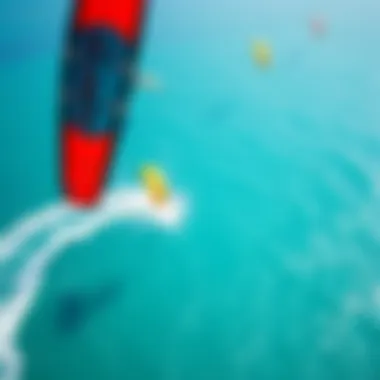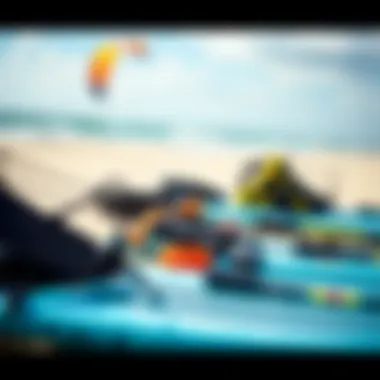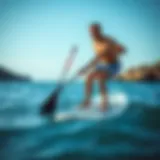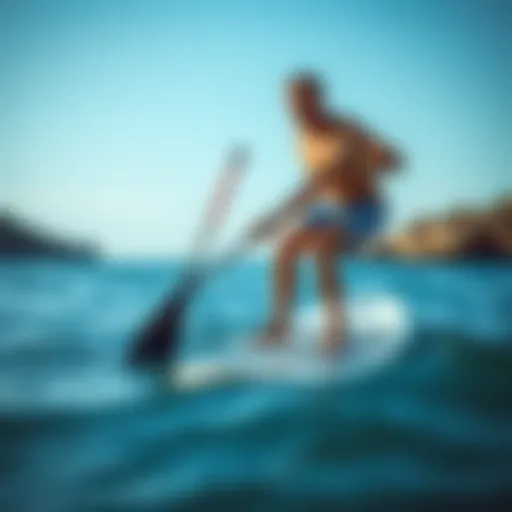Kitesurfing in Miami Beach: A Thrilling Adventure


Intro
Kitesurfing in Miami Beach is not just a sport; it’s a lifestyle that intertwines adventure, skill, and the captivating backdrop of sun-kissed shores. The region’s climate and geographical nuances make it a prime destination for enthusiasts looking to harness the wind and waves. In essence, this article aims to provide you with a robust understanding of kitesurfing here—from the best spots to the necessary skills, and from local culture to vital safety practices.
Picture yourself gliding across turquoise waters, powered by a colorful kite soaring high above you. For both newcomers and those seasoned in the sport, knowing the ins and outs of kitesurfing in Miami Beach can significantly enhance the experience. This narrative will unpack the essentials that every kitesurfer should be aware of, making your next venture into the waves not just enjoyable but enriching. With this in mind, let’s delve in, starting with the surf gear and equipment you’ll need to elevate your kitesurfing game to new heights.
Intro to Kitesurfing in Miami Beach
Kitesurfing in Miami Beach is not just a sport; it's a lifestyle that resonates with many who crave the thrill of wind and water. The appeal lies not only in the exhilarating experience of gliding across the waves but also in the vibrant culture and community that surround it. Here, kitesurfing becomes a dance between the elements, with riders immersing themselves in the beauty of the South Florida environment.
Understanding kitesurfing's significance in Miami Beach is crucial for anyone considering embracing this activity. The unique climate, characterized by warm temperatures and steady winds, creates ideal conditions for both novice and experienced kitesurfers. Those who take the plunge find a rewarding experience that connects them to both the ocean and fellow enthusiasts.
Engaging in kitesurfing offers a myriad of benefits. For one, it enhances physical fitness; riders engage their core and improve their balance, agility, and strength. Moreover, the sport fosters a sense of adventure and encourages individuals to push their boundaries, cultivating resilience and confidence.
However, with the thrill of kitesurfing comes certain considerations. Riders must remain aware of their surroundings, including weather changes and the behavior of other water users. Safety protocols must be established, and proper gear is essential to ensure enjoyable outings without mishaps. Adhering to these factors not only enhances the experience but also safeguards the rich marine environment that makes locations like Miami Beach so special.
In essence, exploring the dynamics of kitesurfing in Miami Beach goes beyond mere recreation; it's about harnessing the energy of the wind, engaging with nature, and becoming a part of a community that prides itself on sharing the stoke of the sport. Whether you're a sun-chaser or just looking for something new, kitesurfing in Miami is where adventure meets the shoreline.
Kitesurfing isn't just a sport; it's a way to connect deeply with nature while enjoying the thrill of riding the waves.
For further insights into Miami's kitesurfing scene, visit the Miami Beach Kitesurfing Association or explore community forums on platforms like Reddit.
The Ideal Conditions for Kitesurfing
When it comes to kitesurfing, the conditions can make or break the experience. In Miami Beach, the mix of wind and water elements forms the perfect backdrop for both beginners and seasoned pros. Understanding these ideal conditions not only boosts your skills on the water but also enhances overall enjoyment. This section sheds light on crucial aspects like wind patterns, water conditions, and tidal influences, all of which play key roles in kitesurfing success.
Wind Patterns and Directions
Optimal Wind Speeds
The wind speed is fundamentally important; it sets the stage for an exhilarating kitesurfing experience. Generally, optimal wind speeds for kitesurfing range from 12 to 25 knots (about 14 to 29 mph). At these speeds, riders can experience a balanced mix of control and speed. Winds blowing in this range provide just enough lift to get airborne without knocking you off your board or making it hard to steer your kite.
Why is this important? Winds beyond 25 knots can turn a good time into a daunting battle against the elements. Excessively strong winds may lead to rig damage or, worse, injuries. Conversely, if the winds dip below 12 knots, you'll find yourself struggling to get traction.
Understanding Wind Directions
Equally important to wind speed is its direction. Wind coming from the east is generally favored, as it sweeps across the open ocean and pushes against the beach.
Wind direction, especially for novice kitesurfers, dictates the choice of spot and the type of kiting experience you'll have. A northeast wind offers the chance for flat-water kiting, making it easier to learn new tricks and refine skills.
Moreover, understanding wind angles helps in planning your rides effectively. For instance, a direct onshore wind might sound appealing but can create tricky conditions, pushing you back on every wave.
To sum up, grasping wind directions and their implications allows kitesurfers to navigate the waters intelligently and safely.
Water Conditions
Wave Types
Different wave types can significantly alter your kitesurfing experience. In Miami Beach, you can find everything from choppy waters to smooth swells. For beginners, smaller, less aggressive waves offer safe learning environments while more skilled riders might seek out the thrill that comes with larger swells.
Understanding wave types helps you choose which area to kite and influences your style of riding. For instance, smaller waves allow for gentle rides that focus more on control, while bigger, crashing waves demand advanced skills in navigation and power management.
It's essential to match your skill level with the conditions. Picking a spot where the waves complement your ability ensures a safer and more rewarding experience.
Best Tide Conditions
Tides can be a tricky factor as they create fluctuating water levels that can enhance or diminish your kitesurfing experience. For Miami Beach, the best conditions often come around medium to high tide. During these times, the water is at a level that provides a good mix of flat sections and small waves.
Why does this matter? Low tide can expose shallow areas, resulting in potential hazards and an uncomfortable ride. By checking tide charts, kitesurfers can plan their sessions around the optimal conditions.
In summary, synchronizing your kitesurfing sessions with the best tide conditions not only promotes a safer experience but also enriches your riding adventure.
"Success in kitesurfing is about working with nature, understanding the wind, waves, and tides. Utilize these for an optimum ride!"
In the vibrant environment of Miami Beach, taking a keen interest in these ideal conditions can greatly enhance your kitesurfing journey.
Best Kitesurfing Spots in Miami Beach
Kitesurfing is not just a sport in Miami Beach; it’s a lifestyle, a culture that thrives on the strong winds and stunning coastlines. In this vibrant setting, the right spot for kitesurfing is as vital as the kite itself. Choosing an ideal location can significantly influence your experience—be it the thrill of riding waves or simply enjoying a leisurely glide along the azure waters. The best kitesurfing spots in Miami Beach are emblematic of what makes this city a prime destination for enthusiasts from novice to expert levels.


Each location offers its own unique characteristics, from wind patterns and water conditions to the scenery surrounding it. It’s crucial to pick the right beach tailored to your skill set and what you’re aiming to achieve during your sessions. Whether you’re looking for calmer waters to hone your basic skills or more challenging conditions for advanced maneuvers, Miami has got you covered.
Key Biscayne
Key Biscayne is often regarded as a crown jewel for kitesurfers thanks to its consistent wind and picturesque surroundings. Nestled between the Biscayne Bay and the Atlantic Ocean, this spot provides a unique mix of fun and beauty.
- Wind Conditions: Key Biscayne tends to be windy almost year-round, with the sea breezes offering optimal conditions for kitesurfers of all levels.
- Safety: Ample space for take-offs and landings minimizes risks. You don’t feel crowded, which is a blessing on busy weekends.
- Facilities: The area boasts good amenities including parking, bathroom facilities, and nearby eating spots to refuel after an exhilarating session.
South Beach
South Beach, or SoBe as the locals call it, is famous for its bustling atmosphere and vibrant nightlife. But the beach is equally known for its thrilling kitesurfing environment. Here, kitesurfing isn't just a sport; it’s part of a lively scene that pulsates with energy.
- Atmosphere: The backdrop of art deco buildings and a busy beach atmosphere complements your ride, creating both fun and excitement.
- Accessibility: Being central, South Beach allows easy access to kitesurfing gear rentals and lessons. It’s a great location for beginners wanting to learn amidst a lively crowd.
- Challenges: It's worth noting that the waves can get a bit choppy here, so it’s ideally suited for those with a bit of experience.
Hobie Beach
Hobie Beach is perfect for those looking to escape the crowded spots while still enjoying good wind and water conditions. Tucked away from the hustle and bustle, it’s less frequented, offering a more peaceful setting.
- Ideal for Beginners: With its calmer waters, this beach is superb for anyone just starting out, making it easier to learn the ropes.
- Friendly Vibes: The community here is welcoming, and you’ll often find experienced kitesurfers willing to share advice with newcomers.
- Natural Beauty: The scenic views of the nearby islands and the skyline further contribute to a more tranquil riding experience.
"Finding the right spot to kitesurf can transform your session from a simple ride into an unforgettable experience. Each beach adds its unique flavor to the sport, and Miami Beach offers a variety of options to cater to every kitesurfer's taste."
In summary, picking a kitesurfing spot in Miami Beach involves assessing your skill level and the type of experience you want to enjoy. Each of the locations mentioned brings its own advantages, making it essential for surfers to familiarize themselves with these local gems.
Getting Started with Kitesurfing
Kitesurfing is an invigorating activity, appealing to both thrill-seekers and those who are keen to spend time in nature. Diving into this sport can be daunting for beginners but it’s well worth the effort. When you decide to start kitesurfing in Miami Beach, the first steps you take will lay the ground for your future adventures on the water. Understanding the basics ensures not just your safety but also your enjoyment in mastering this captivating sport.
Essential Gear and Equipment
Kites
Kites are at the heart of kitesurfing, serving as the engine for your ride. The chosen kite must suit the rider’s skill level, style, and the wind conditions. There are various types of kites, each with unique characteristics. For instance, inflatable kites are popular for their stability and ease of use; they provide a good balance that makes them accessible for newcomers. However, a drawback might be the learning curve associated with handling various sizes, which can affect performance based on wind strength.
The flexibility to switch between different sizes is beneficial, allowing kitesurfers to fine-tune their experience. It's wise to consult with local shops or experienced riders to understand which kite suits your initial needs.
Boards
The choice of board plays a significant role in kitesurfing and can drastically affect the riding experience. Different boards are designed for different styles. For instance, directional boards are tailored for wave riding while twin tips provide versatility and are great for tricks and freeriding. A twin tip board can be seen as a comfortable choice for beginners because it offers the option for both stance directions, making it easier to maneuver across the water without worrying about which way is forward.
That said, directional boards can give an exhilarating feeling when riding waves, but mastering them takes some time and practice. Therefore, those starting out often lean towards twin tips due to their forgiving nature and ease of use.
Harnesses
A harness ties the kitesurfer to the kite and is a crucial piece of equipment. Harnesses come primarily in two types: seat harnesses and waist harnesses. A seat harness provides extra support for beginners by wrapping around the hips and preventing it from riding up. This can be comforting when you’re just getting your feet wet. However, a waist harness allows for more freedom of movement and is often preferred by experienced riders aiming for tricks. Each type presents its own set of advantages, and it’s essential to find a harness that feels comfortable and fits well. Choosing incorrectly may hinder your performance and enjoyment.
Basic Techniques for Beginners
Launching and Landing
Learning how to launch and land a kite safely is a fundamental skill any kitesurfer must acquire before hitting the water. Proper launching helps to avoid mishaps that could cause injury or equipment damage. This often involves finding a safe spot where you can control the kite while someone assists with launching. A common technique involves having the kite at the edge of the window for a smooth ascent into the air.
The landing process is equally critical; understanding how to guide the kite down gently keeps the sport enjoyable. By practicing these techniques repeatedly, beginners can eventually build confidence.
Controlling the Kite
Kite control is imperative for successful kitesurfing. One key aspect is learning how to effectively use the control bar; this bar acts as the control center for your kite. It allows you to steer and manage power, impacting your ride and the maneuvers you can perform. Mastering how to pull on the bar to gain power or release it to depower the kite is a crucial skill.
The unique nuance of controlling the kite lies in understanding how it reacts to nuances in wind conditions. For example, a slight position change can significantly alter the kite's performance. Thus, practicing in varied conditions adds to your adaptability on the water.
Focusing on these key elements provides a solid foundation for any beginner aiming to thrive in the thrilling world of kitesurfing.
By grasping your gear and foundational techniques, you'll find yourself more than ready to tackle the expansive waters of Miami Beach, where adventure awaits around every wave.
Advanced Techniques for Experienced Kitesurfers
Kitesurfing is not just a sport; it's a combination of skill, art, and a deep connection with nature. As kitesurfers progress, they often look to refine their skills through advanced techniques. This section emphasizes why mastering these techniques can elevate the overall experience, boosting both performance and safety while riding the waves in Miami’s dynamic waters.
The techniques discussed here open up new horizons for experienced kitesurfers, allowing them to adapt to different conditions and explore the full potential of their capabilities.


Jumping and Tricks
Jumping and executing tricks on a kiteboard not only adds excitement but also showcases a kitesurfer's proficiency. For seasoned riders, these moves can establish a level of artistry on the water that captures attention.
Proper Techniques
When it comes to jumping, the proper technique serves as the foundation for launching into the air safely. Key aspects include timing your kite’s position and using your body weight effectively. Many riders believe that mastering the energy from the water and wind can lead to larger, more controlled jumps.
One main characteristic of proper technique is its ability to prevent injuries. Instead of risking a hard landing, utilizing correct timing and positioning helps cushion falls, making it safer for experienced kitesurfers to push their limits. This makes it a cornerstone of advanced kitesurfing. Plus, skilled jumps can lead to opportunities for creative aerial maneuvers.
Advantages of following proper techniques include:
- Improved control during jumps
- Reduced risk of injury
Spotting Landing Areas
Spotting landing areas is another crucial technique. It involves observing the landscape and choosing a suitable spot to land after a jump. Understanding the right place to land can prevent disasters and ensure a smooth ride back to the surface.
A vital characteristic of spotting landing areas is the awareness it promotes. A kitesurfer who can identify hazards such as rocks or shallow water demonstrates a strong understanding of their surroundings, enhancing overall safety. This technique is especially beneficial in varying sea conditions, where changes can happen without warning.
The unique feature of this technique lies in its role in ensuring smooth transitions and flow upon landing. The advantage of honing this skill is the ability to navigate various environments and conditions without compromising safety or performance.
Riding Different Types of Waves
Mastering different wave types is essential for any experienced kitesurfer. It can transform an ordinary session into a thrilling encounter with the ocean’s power.
Small Waves vs. Bigger Swells
Kitesurfers often face small waves contrasting with bigger swells. Each offers different riding experiences and requires specific strategies. Smaller waves are often more forgiving, allowing for easier handling and less risk of wipeouts, making them a great choice for practicing tricks and techniques without as much consequence.
On the other hand, bigger swells demand heightened focus and a distinct approach. Riding larger waves can be exhilarating but also presents challenges with balance and control. The key characteristic here is adaptability; experienced kitesurfers must be comfortable transitioning their techniques based on the wave size, harnessing the ocean's energy effectively.
The advantage of knowing both styles of riding gives kitesurfers a diverse toolkit, enabling them to tackle various conditions with confidence. However, the drawback often lies in the unpredictability of larger waves, demanding a more refined skill set and increased vigilance.
Riding Direction and Positioning
The technique of riding direction and positioning plays a critical role in kitesurfing performance. Proper orientation towards wind and waves can significantly influence the quality of the ride. This means focusing on body positioning for optimal kite control and energy conservation.
A key feature of excellent positioning is its role in maximizing speed and minimizing drag. Not only does it improve performance, but it also allows kitesurfers to react efficiently to changing conditions. Experienced kitesurfers focusing on their direction can harness the wind’s power without losing balance or control.
The advantages of mastering direction and positioning include:
- Enhanced performance in various conditions
- Ability to ride longer without exhaustion
Riding in town like Miami Beach with a focus on these advanced techniques undoubtedly opens up a wider range of possibilities for kitesurfers looking to elevate their game, embrace new challenges, and ensure a thrilling experience on the water.
Safety Considerations for Kitesurfers
Kitesurfing can be a thrilling activity, but it’s vital to tackle it with the right mindset regarding safety. Understanding and addressing safety considerations ensures not just a fun experience, but also a secure one. The ocean rewards the prepared and punishes the careless. In Miami Beach, the winds and waves may entice many to take to the water, but neglecting safety can lead to dire situations. By focusing on weather awareness while maintaining control of your kite, you lay down a solid foundation for an exhilarating journey.
Weather Awareness
Understanding Storm Patterns
One of the most crucial aspects of kitesurfing safety is having a firm grasp of storm patterns. It’s not uncommon for weather can shift like a deck of cards in the tropics. Recognizing early signs of incoming storms can mean the difference between a perfect kite session and a panic-stricken dash back to shore. Keep an eye on the skies and charts that show cloud formations; they can be a telltale sign of brewing trouble.
A vital characteristic of storm patterns is their unpredictability. A clear sunny day can swiftly morph into a tempest if you’re not paying attention. Frequent storms can lead to elevated water levels and shifting currents, making it less safe to ride. Therefore, understanding these patterns aids in making informed decisions about when to hit the waves.
"It’s better to be cautious than to wind up in a hair-raising situation, especially while dealing with the robust nature of oceans."
Monitoring Wind Changes
Now let’s talk about wind changes. Wind serves as the engine for your kitesurfing; however, those changes can hit quickly and without warning. Your experience can be disrupted if the wind picks up more than expected or shifts directions. Adjusting to these changes is vital in ensuring a safe ride.
The key characteristic of monitoring wind involves being diligent and observant. Why is it important? A sudden increase in wind speed can throw you off balance, causing loss of control or even riskier scenarios. Noticing shifts in wind direction helps you plan your movements better and avoid getting caught in less favorable situations.
From turbulent gusts to smooth breezes, understanding how to read the wind plays a significant role. Much like reading the room in social situations, it’s all about awareness and adaptability.
Kite Control and Safety Gear


Types of Safety Gear
The right safety gear can safeguard you when things take a turn. Kiteboarding equips you with various types of safety gear, such as helmets, impact vests, and quick-release systems. These pieces not only boost confidence while riding but also provide an added layer of protection.
Each type of gear has unique features and advantages. A helmet, for instance, shields your noggin against unforeseen impacts, while a quick-release system allows you to disconnect from your kite in emergencies. This makes it a fundamental choice in any kitesurfer's gear arsenal.
But why opt for safety gear? It's simple. It fosters peace of mind and encourages you to push your limits without worrying about safety in turbulent conditions.
How to Use Safety Equipment
Lastly, understanding how to operate your safety equipment can save your life. It’s not just about wearing gear; knowing how to effectively use it is equally important. For instance, practicing the quick-release system on your harness until it becomes second nature is not to be overlooked.
The core characteristic here is familiarity. The better you know your gear, the more instinctive your responses will be in times of distress. Taking time to familiarize yourself with each peace of equipment ensures you're not fumbling around when the pressure is on.
By learning the features of your safety equipment, kitesurfers can enhance their overall experience whilst minimizing risks. No one wins at kitesurfing if they are not respecting the boundaries and preparing for the unpredictable.
Ensuring your kitesurfing excursions are both enjoyable and safe is paramount. As you venture into the dazzling waves and breezy skies of Miami Beach, remember that your safety prepares you for the adventure ahead.
Community and Culture of Kitesurfing in Miami
Kitesurfing in Miami is not merely an exhilarating sport; it is intricately woven into the fabric of the local culture. This community is vibrant, diverse, and welcoming, making it an essential aspect of the kitesurfing experience. For newbies and seasoned riders alike, connecting with fellow enthusiasts can enhance skills and foster friendships. The shared passion for kitesurfing brings people together, creating a supportive environment where individuals can learn and grow.
One significant benefit of being part of this community is access to collective knowledge. Local riders often share tips about the best times to hit the water, ideal gear recommendations, and knowledge about environmental conditions unique to the area. This not only enhances a rider's skills but also deepens their connection to the sport and surrounding nature.
Moreover, the culture surrounding kitesurfing in Miami encourages sustainability and respect for nature. Riders are often advocates for preserving the local environment, ensuring that the beaches and waters remain pristine for future generations. This sense of responsibility creates a bond among kitesurfers, reinforcing their loyalty to the sport and its impact on the environment.
Local Kitesurfing Schools
Recommended Schools and Instructors
When it comes to getting involved with kitesurfing in Miami, local schools play a pivotal role. Schools such as Miami Kiteboarding offer experienced instructors who cater to all skill levels. Their facility is notable for its personalized approach and emphasis on safety, making it a popular choice among both new and experienced riders.
These instructors typically have strong backgrounds in water sports and a genuine passion for teaching. Their unique feature is the use of a tailored teaching method that adapts to each student's pace and learning style. This customized approach can significantly boost a beginner's confidence while ensuring experienced kitesurfers refine their techniques.
However, it is important to weigh the pros and cons. While the cost of lessons at these schools might seem steep, the quality of instruction and safety measures often outweigh these concerns, providing undeniable value.
Kitesurfing Events and Competitions
Annual Competitions
Annual kitesurfing competitions in the Miami area draw both participants and spectators from around the globe. Events like the Miami Kiteboarding Cup highlight the incredible talent within the community. These competitions are a celebration of skill, showcasing thrilling tricks and fierce rivalry.
What sets these competitions apart is their inclusivity. They cater to various skill levels, encouraging even novices to participate or simply enjoy the excitement as spectators. Furthermore, these events promote community growth; sharing experiences and witnessing the talent on display can spark inspiration for many riders.
Local Gatherings
Local gatherings form another crucial component of the kitesurfing culture in Miami. These informal meetups, often held on weekends at popular beaches like Hobie Beach, create opportunities for riders to connect outside of a structured setting. Participants can share personal experiences, teach each other tricks, or even just enjoy a day on the water together.
A key characteristic of these gatherings is their laid-back atmosphere. Riders don’t have to worry about formalities, allowing for genuine interactions. Additionally, they foster a sense of belonging, making newcomers feel welcomed into the kitesurfing family.
Environmental Concerns in Kitesurfing
Kitesurfing, while exhilarating and visually striking, carries its fair share of environmental implications. In Miami Beach, the harmonization between human excitement and nature's well-being is paramount. As kitesurfers glide along the stunning coastlines, understanding the environmental concerns tied to the sport becomes essential. This not only helps protect local ecosystems but fosters a culture of awareness and responsibility among kitesurfers.
Impact on Local Ecosystems
Protecting Marine Life
Marine life is the backbone of coastal ecosystems, and kitesurfing interacts with this delicate balance. The thrill of kitesurfing often takes place near waters that host various species, including sea turtles, rays, and colorful fish. These creatures are sensitive to disturbances — particularly from activities that alter their habitats.
Caring for marine life isn't just an ethical choice; it also enhances the health of these ecosystems. A healthy marine environment contributes to cleaner waters and vibrant biodiversity, directly benefiting the kitesurfing experience itself. By practicing mindful navigation and avoiding sensitive areas, kitesurfers can actively participate in the conservation of local marine life. The incorporation of respect toward wildlife translates into a sustainable future for the sport.
Preserving Marine Habitats
Just as protecting marine life is critical, preserving marine habitats requires equal attention. Kitesurfers often gather in areas that have diverse underwater landscapes, like seagrass beds and coral reefs. These habitats offer refuge and nourishment for numerous aquatic organisms. When kitesurfing, it’s vital to be aware of boat traffic, pollution, and other external factors affecting these habitats. Maintaining the integrity of these ecosystems helps ensure that young kitesurfers have a vibrant environment to explore.
Kitesurfers play a crucial role in safeguarding these precious locations through responsible practices. The unique characteristic of marine habitats is that they often serve numerous functions, including carbon storage and coastal defense against storms. Thus, actively promoting habitat preservation dramatically enhances the region’s health, becoming a benefit for both nature and the sport itself.
Sustainable Practices for Kitesurfers
Sustainability isn’t just a buzzword; it’s a necessity for anyone who enjoys the beauty of our oceans and beaches. For kitesurfers, adopting sustainable practices can mean the difference between thriving ecosystems and degraded environments.
Choosing Eco-Friendly Gear
As kitesurfing enthusiasts, the gear we use plays a pivotal role. Opting for eco-friendly equipment not only reduces individual ecological footprints but also sets a precedent within the community. From biodegradable kite materials to harnesses made from recycled fabrics, choices abound for the eco-conscious rider.
The trend toward sustainable gear reflects a growing awareness of environmental issues in sports. This choice not only protects marine life but also shows a commitment to the overall wellbeing of oceanic ecosystems. By supporting companies that prioritize sustainability, kitesurfers can contribute to a positive cycle of eco-friendly practices.
Respecting Natural Areas
Respecting natural areas is more than just a guideline; it's a philosophy for every kitesurfer. Staying within designated kite zones, avoiding nesting areas during peak seasons, and cleaning up after oneself are foundational to maintaining the natural beauty of Miami Beach. Every kiteboarder can contribute to this effort, which helps keep these areas pristine for future generations. The unique feature of respecting natural areas is the emphasis it places on securing our enjoyment of the sport while ensuring the same opportunities for others. Ignoring this aspect can lead to restrictions in access to popular kitesurfing spots, undermining the shared joy of the experience. Hence, the call is clear: support, preserve, and respect the beautiful environments that we play in.















